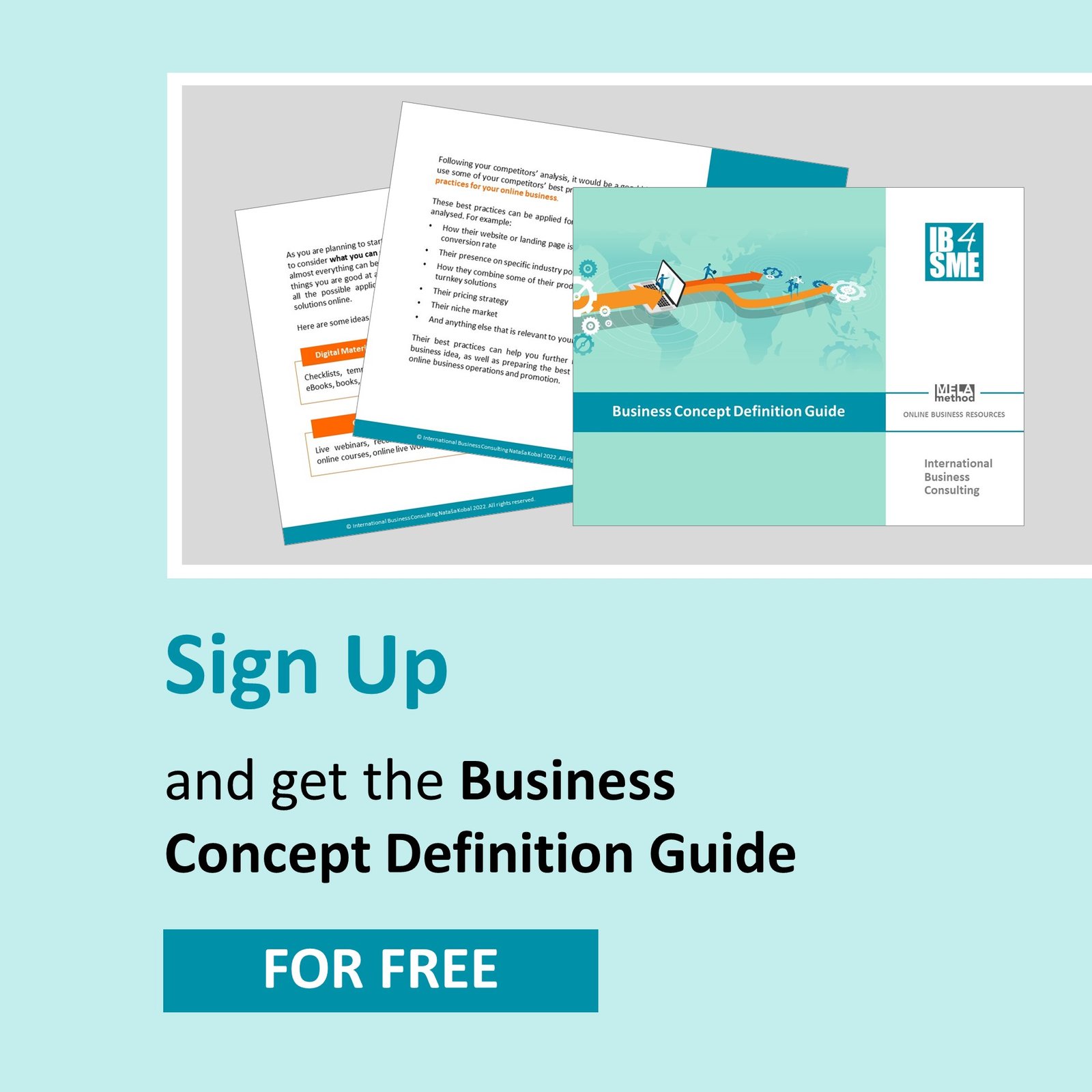Every business needs to make sales to survive. In order to sell, you need to promote your business in some way. Here is where marketing comes into play. Having a marketing strategy is important because it helps you promote your business by defining how you communicate your solutions to potential customers and through which channels.
In this article you will learn the following seven basic elements of a simple marketing strategy that will help you prepare the marketing strategy for your new business:
- Step 1: Purpose and Objectives
- Step 2: Target Audience
- Step 3: Pricing Strategy
- Step 4: Promotional Plan
- Step 5: Marketing Budget
- Step 6: Visuals
- Step 7: Content Writing
- Summary: How to prepare your own marketing strategy?
Before proceeding, if you are not really familiar with marketing yet and don’t understand some of the terms used in this article, take a look at these 40 Marketing Terms for Beginners, another useful article of the IB4SME Blog.
Step 1: Purpose and Objectives
The first thing you need to prepare are the purpose and objectives of your marketing strategy. The main purpose for your marketing strategy is most probably to promote your online business or your main solution to target customers in target markets in order to achieve a fast market entry.
In line with your purpose, you can then define the objectives of your marketing strategy. Objectives are usually related to what you want to achieve from a business perspective (e.g. establish your business or brand image and recognition, support sales through lead generation, etc.), or from a communication perspective (e.g. promote your solution to the target audience, provide relevant information about your solution, etc.).
Make sure you define properly your marketing strategy purpose and related objectives before your proceed further. You need to know where you are going in order to prepare a strategy to achieve that.
Step 2: Target Audience

You need to properly define your target customers and their needs in order to offer them solutions that they will buy. Your target customers will in most cases by also your target audience and it is very important for you to understand their problems and needs, what they want to achieve and what they are prepared to pay for in order to achieve their goals. Once you have a clear understanding about who your customers are, you just need to define a few characteristics.
The key characteristics of your target audience for your marketing strategy can include the following:
- Key demographic details (age, gender, nationality etc.)
- Location (needs to be in your target markets)
- Spoken languages (considering the language used in your solution)
- Key characteristics related to your solution.
Step 3: Pricing Strategy
A pricing strategy is related to your decision (strategy) of what prices to give to your solutions, or other products and services, in order to attract your target customers to buy from you. A good way to define your prices is to check the prices of similar solutions provided by your competitors and either set the prices in a similar range but offering a greater value, or provide the same value, but at a lower price.
In defining your prices you also need to consider how many customers need to buy your solution at a set price in order to achieve your target profit. The IB4SME Pricing Strategy Template is a great tool that can help you prepare your pricing strategy considering all the relevant elements of your business and sales.
Step 4: Promotional Plan
To promote your online business, you need to define which activities and channels you will use. But you need to make sure to promote your business and solution by targeting your target customers and communicate the same messages in a consistent way through various channels.
The most common and useful activities and channels that you can use in your own marketing strategy include:
- Advertising
- Email marketing
- Social media marketing
- Landing pages
- Search Engine Optimisation (SEO)
- Events.
To make it easier and faster for you to prepare your promotional plan, the IB4SME Promotional Plan Template already includes all the key elements you might need for your plan, as part of your Marketing Strategy.
Step 5: Marketing Budget

Apart from free marketing activities, all your other marketing activities, which you need to pay for, will depend on available funds, i.e. your marketing budget. Therefore, you need to plan paid marketing activities within your marketing strategy considering your budget first.
Let’s say, for example, that you have EUR 3,000 to use for marketing in a specific period (e.g. for 6 months). Now you need to split this budget between the paid marketing activities that you expect will bring you the best returns. Examples of paid marketing activities include online advertising (e.g. Google Ads, Facebook Ads etc.), paid email marketing automation software, landing pages developed by a marketing agency, visuals for your advertisements or social media posts, events you need to pay to attend or sponsor, and other.
But there are also marketing channels, which you can use for free. These include, for example: email marketing (if you use a free version of an email marketing platform), social media marketing (e.g. posts, sharing news, publishing videos etc.), landing pages that you can prepare on your own on your existing website, online events you can organise on your own (e.g. webinars, workshops etc.), and SEO that you do on your own.
Once you allocate how much of your budget you will spend for each paid marketing activity, make sure you monitor that budget regularly to not go over budget.
Step 6: Visuals
Visuals are also a very important aspect of your marketing strategy. Therefore, you need to pay a lot of attention on the visual elements of your online content, such as your advertisement layout, social media posts images, layouts and images present on your website, emails and landing pages. All these visuals need to be always prepared in line with your brand guidelines, presenting a consistent application of your visual identity in all layouts, and be also aligned with the message you are trying to convey.
No matter how capable, smart, knowledgeable, or experienced you are, you can’t do everything on your own and get the results you want. Therefore, you might need to see professional help for the things you can’t well do on your own, such as eventual graphic design services or landing pages development.
Step 7: Content Writing
Within your marketing strategy, content is king, or queen if you prefer. In today’s information overload, it is hard to find really good and useful content amongst all the rest. That’s why providing original, engaging and useful content becomes even more valuable, brings you more visitors and customers, and makes your pages rank higher in search engines.
Before you start working on any content, it is a good idea to prepare your content style guide. In the style guide, you need to define the following aspects:
- Your audience/buyer personas
- Your brand characteristics
- How your audience should perceive your brand
- Your voice
- Your tone
- Your style.
If you want to prepare the content style guide on your own, but you don’t know how to do it, you can use the IB4SME Content Style Guide Template.
Summary: How to prepare your own marketing strategy?
By following the seven steps presented above, you should be able to prepare a good marketing strategy to promote your solution online. Here are the most important questions you need to answer and consider while preparing your marketing strategy:
- What are the purpose and objectives of your marketing strategy?
- What is your target audience?
- What is your pricing strategy?
- Which channels are included in your promotional plan?
- How will you use each of these channels?
- What is your marketing budget?
- How is your marketing budget split by channel?
- Who will prepare your visuals and what guidelines you need to follow?
- Who will write all the content and what guidelines you need to follow?
The seven steps briefly presented in this article can serve as a base for you to prepare your own marketing strategy. However, if you never prepared a marketing strategy or another similar document, it would be better for you to use the IB4SME Marketing Strategy Template and other material present in the Digital Marketing Toolkit.
Apart from your marketing strategy, as an entrepreneur or a new small business owner, there are also other business and marketing-related aspects you should consider in order to have a successful business. In the Mompreneurs Online Business Handbook I cover all the most important aspects of defining your business concept and model, your brand, and your solution, as well as how to successfully promote your business online. This is a practical guide to start a successful online business from home, which I prepared by putting on paper my knowledge, experience and know-how, to help you and guide you step by step throughout the business concept, planning and setup processes of your new online business.



